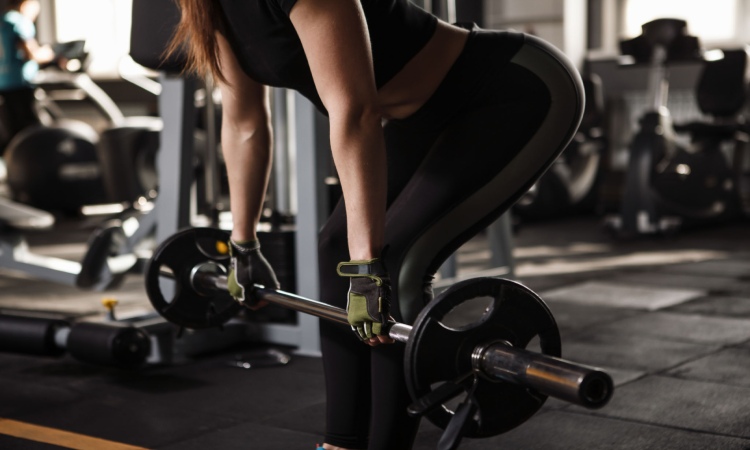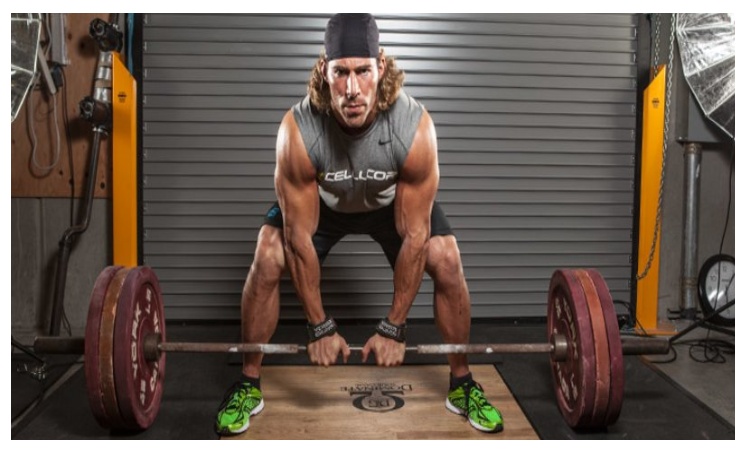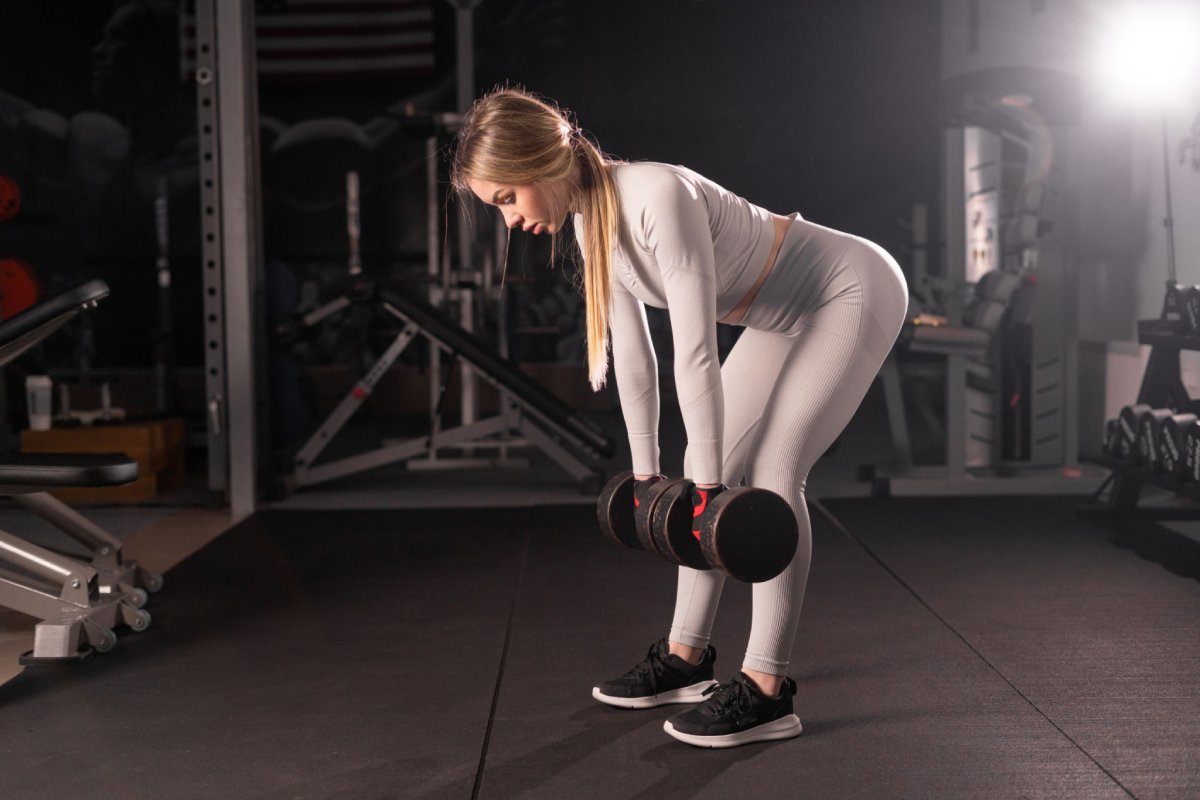Stiff leg Deadlift – One of the basic exercises you should know and learn to develop strength, and a large amount of muscle mass in your legs is the deadlift, known by its English name «Deadlift». This exercise offers you many benefits that you will learn about below.
With a first impression, this exercise is often feared as “my back will hurt when I lift the weight from the ground”, “my back will hurt from lifting a lot of weight”. I understand that deadlifting can seem dangerous at the beginning of a training program. Still, if you use proper technique and correct progression, you will like this exercise.
Personally, it’s one of my favourite exercises and little by little. It’s also become one of Laura’s favourites (thanks for the photo Laura, the technique is perfect, and Arturo, your kitty, was infallible). This exercise helps her maintain good posture and strong legs, among other benefits.
Table of Contents
Stiff leg Deadlift What is it?
Also known as Stiff leg Deadlift by its English name. This exercise will summarise another series of movements, such as the Swing and the Clean. For now, we are profitable to focus on the deadlift and later, you will be able to know the exercises that follow it.
By practising the deadlift, you will have better motor control of your body, your hip mobility will increase, and you will know the activation of the correct muscles (mainly hamstrings) for this movement, minimizing the risk of injury.

Stiff leg Deadlift Benefits
1. Improve your posture with te deadlift
This movement is essential to know how we move during the day and how we should improve that quality of training.
When bending down to choose an item from the floor, shopping bags, or anything on the floor, you will need a specific technique and, of course, strength to do it. At this point, the deadlift comes into play.
Once you learn the deadlift, you will know which muscles to activate and the true power of your glutes and hamstrings while possession your back aligned and straight by focusing the force on your legs when lifting objects of different weights from the floor.
Having good technique and learning the hip hinge pattern makes it easier for you to do everyday activities, like when you want to pick something up off the ground.
2. Your Muscles are the Main Source For Burning Fat
The exercises that I usually recommend in my training programs are the ones that involve the most incredible amount of muscle mass. Why?
The more muscle mass you need to use for a particular exercise (in this case, deadlift), the greater the amount of energy (calories) you will need for that movement during training
But that’s not all. It’s not just a matter of calories. Maintaining your muscles also requires energy, which can come from food and fat tissue in your body (you’ll burn your reserves without training to strengthen your muscles). Therefore, strength training and especially practising this type of workout will help you lose fat more quickly and efficiently.
3. Activate Every Muscle During the Exercise
Similar to the previous point, this exercise engages many muscles. When you do a deadlift for the first time, keep in mind that with this exercise, you will be able to lift a lot of kilos since you will be using your legs, glutes, arms, back, abdomen and robust hamstrings.
4. Anti-Chair Motion
During the day, we spend hours and hours sitting. This exercise will prevent sleeping muscles from being in the same position during the day. In addition, when you get up and stand with your body extended in the final phase of the deadlift, your shoulders will go back, and you will expand your chest, thus improving your body posture with each repetition.
5. It will Boost your Confidence
The stiff leg deadlift is the first part of many other exercises that come with it. When you gain confidence with this move and perfect your hip hinge pattern, you can move on to more exciting movements such as the Swing, Barbell Deadlift, Stiff leg One Foot Deadlift, and more.
6. More Power
Walk more without getting tired quickly, run faster, have more confidence when jumping and get off the ground without problems. The deadlift not only builds muscle mass, so you have an aesthetic body, but it will also make you faster and more agile.
Deadlift with Stiff Leg Muscles
The muscles you are going to engage during the stiff leg deadlift are:
Quadriceps.
hamstrings
Buttocks.
Adductors.
Spinal erector.
Trapeze.
Lower back.
Forearms.
Abdomen (core).
I didn’t find a video using a stiff leg; however, doing the barbell deadlift, the muscles you’ll use are similar.
Stiff leg Deadlift Technique
You start with your feet hip-width apart with the handle of the stiff leg in line with the middle of your feet.
Please take a deep breath over your nose and activate your abdomen by contracting it, creating tension throughout your body. While maintaining pressure, send your hips back to achieve the hinge position.
Imagine holding a tennis ball between your chin and chest. This will keep your neck and back in a neutral position through movement. (LOOKS AT THE GROUND WHEN GOING DOWN).
Grab the stiff leg with equal hands and bring your lats down and away from your ears (lower your shoulders).
Think of externally rotating your elbows, turning the inside of your elbow to face forward. At this point, you would feel the tension in your hamstrings.
Before standing up, imagine splitting the floor with your feet to engage your glutes and maintain tension in your lower body. Press down hard on the ground with your toes (as if you wanted to grip the floor with your feet).
Move your hips forward to full extension, exhaling through your nose, reaching a full standing position, and voluntarily contracting your glutes in this final phase of the exercise. (LOOKS FORWARD WHEN CLIMBING).
Then repeat, returning to the starting position by sending your hips back to bring the stiff leg to the ground.

How to Do the Stiff Leg Deadlift
Here are some extra guidelines to keep in mind when doing the stiff leg deadlift.
Push your hips (bending at the waist) back, keeping your back neutral.
Have your weight on your heels and your chest “open” up.
Allow the stiff leg to lower to the floor with one arm outstretched
Pause for 1-2 seconds when you reach the bottom, looking down at the base.
Returning to a standing position, drive your hips forward, contract your glutes, and pause for 1-2 seconds. Do not lean back, and the force of contraction is done with the buttocks.
Remember that the deadlift serves to mobilize the hips, not to bend the knees excessively.
The deadlift movement is born from the hip, not your lower back (lumbar). If you feel pain in this part, check your posture before continuing to do the exercise.
Stiff Leg Deadlift
In the “star”, I write pressing the stiff leg. In this way, you will put tension on your upper back, helping it to be stable. On many occasions, the deadlift usually causes discomfort in the lower back because the effort of the exercise is taking it to the lower back and not the hamstring muscles, the real protagonists in this movement.
Types of stiff leg deadlifts
There are many differences between the stiff leg deadlift. The important thing is first to have a good base and technique and then move on to more advanced progressions or even use more weight in the exercise.
Romanian stiff leg deadlift.
Sumo stiff leg deadlift.
Unilateral stiff leg deadlift.
Single leg stiff leg deadlift.
Deadlift with two stiff legs.
Conclusion
Did this article help you achieve the stiff leg deadlift? If there are still doubts in the comments section below, you can ask me what you need, and I will see how to help you. Take care of yourself and see you at the next weight training.
Related searches
[stiff leg deadlift]
[straight leg deadlift]
[straight leg deadlift]
[stiff leg deadlifts]
[stiff leg]
[barbell straight leg deadlift]
[stiff legged deadlift]
[stiff deadlift]
[stiff leg dead lift]
[stiff leg barbell deadlift]
[stiff legged dead lifts]
[stiff leg dead lifts]
[stiff legged barbell deadlift]
stiff leg deadlift form]
[stiff leg deads]

